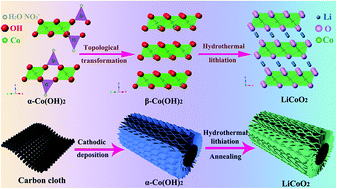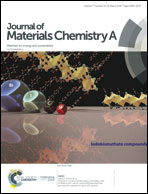Low-temperature synthesized self-supported single-crystalline LiCoO2 nanoflake arrays as advanced 3D cathodes for flexible lithium-ion batteries†
Abstract
Flexible lithium-ion batteries (LIBs) are the essential power sources for the fast developing flexible electronics. The fabrication of flexible cathodes with a self-standing feature on flexible substrates, however, is still a great challenge. Here, single-crystalline self-supported LiCoO2 nanoflake arrays are directly grown on carbon cloth by a facile “hydrothermal lithiation” with low-temperature (380 °C) annealing. This low-temperature lithiation can effectively convert layered Co(OH)2 nanosheet arrays into layered single-crystalline LiCoO2 nanoflake arrays without severe morphology change. Benefiting from the 3D nanoarchitecture, the LiCoO2 cathode exhibits a large specific capacity (130 mA h g−1 at 0.5C), superior rate capability (90 mA h g−1 at 10C) and good cycling stability (81.6% retention after 500 cycles). By using LiCoO2 nanoflake arrays as the cathode and TiO2(B) nanosheet arrays as the anode, an all-nanoarray-based flexible LIB full cell is successfully constructed, demonstrating good electrochemical performance and flexibility. The 3D cathode fabrication and its successful application in a full cell provide new opportunities for developing high-performance flexible LIBs.



 Please wait while we load your content...
Please wait while we load your content...